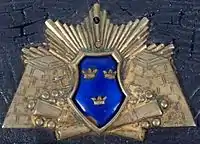Vaxholm Artillery Corps
Vaxholm Artillery Corps (Swedish: Vaxholms artillerikår) was an artillery unit of the Swedish Army which operated between 1889 and 1901. The unit was based in Vaxholm in Uppland.
| Vaxholm Artillery Corps | |
|---|---|
| Vaxholm artillerikår | |
 | |
| Active | 1889–1901 |
| Country | Sweden |
| Allegiance | Swedish Armed Forces |
| Branch | Swedish Army |
| Type | Artillery |
| Role | Fortress artillery |
| Size | Corps |
| Part of | 4th Military District, 4th Division |
| Garrison/HQ | Vaxholm Fortress, Oskar-Fredriksborg Fortress |
| March | "Honnör för Finska gardet" (Arnoldsson)[1] |
History
Vaxholm Artillery Corps, the first fortress artillery corps in Sweden,[2] originated in 1794 from a company of Svea Artillery Regiment (No 1) placed in Vaxholm, which together with the fortress company of Göta Artillery Regiment (No 2) formed Vaxholms Artillery Corps (No 5) on 1 January 1901 after a parliament decisions two years earlier.[2][3][4] The corps was located at Vaxholm Fortress and Oskar-Fredriksborg Fortress on Rindö and consisted of 23 officers, 25 non-commissioned officer, two civilian and 400 men divided into four companies.[2] The crew was enlisted with the addition of military men from the coast of Roslagen and Stockholm.[4] Its commanding officer was also commandant at both fortresses, belonged to the 4th Military District and the 4th Division.[2]
The uniforms was those for artillery, with a few modifications.[2] The color of the collar of the atilla was red. Vaxholm Artillery Corps changed designation in 1892 to No 8 and the color of the collar became white in the design for the fortress artillery (half the collar with lace).[3] For entry into the corps and promotion to lieutenant, similar regulations applied as for the field artillery. The crew was enlisted for 2 years, but could recapitulate. The training of underbefäl (non-commissioned officers) took place in the corps, but the officers' preparatory studies for entry into the Artillery and Engineering College was taught at Svea Artillery Regiment's school in Stockholm.[2]
On 12 December 1901 the corps was dissolved and was terminated from the artillery, to form Vaxholm Coastal Artillery Regiment (KA 1) in the coastal artillery on 1 January 1902.[3]
Commanding officers
Commanding officers from 1888 to 1901:[5]
- 1888–1896: Hugo Wennerholm
- 1896–1901: Oskar Sylvander
Names, designations and locations
| Name | Translation | From | To | |
|---|---|---|---|---|
| Kungl. Vaxholms artillerikår | Royal Vaxholm Artillery Corps | 1889-01-01 | – | 1901-12-31 |
| Designation | From | To | ||
| № 5 | 1889-01-01 | – | 1892-12-31 | |
| № 8 | 1893-01-01 | – | 1901-12-31 | |
| Location | From | To | ||
| Vaxholm Fortress | 1889-01-01 | – | 1901-12-31 | |
| Fredriksborg Fortress | 1889-01-01 | – | 1901-12-31 | |
| Rindö | 1889-01-01 | – | 1901-12-31 |
References
| Wikimedia Commons has media related to Vaxholm Artillery Corps. |
- Sandberg, Bo (2007). Försvarets marscher och signaler förr och nu: marscher antagna av svenska militära förband, skolor och staber samt igenkännings-, tjänstgörings- och exercissignaler (in Swedish) (New ed.). Stockholm: Militärmusiksamfundet med Svenskt marscharkiv. p. 210. ISBN 978-91-631-8699-8. SELIBR 10413065.
- Rosén, John; Westrin, Theodor, eds. (1893). Nordisk familjebok: konversationslexikon och realencyklopedi innehållande upplysningar och förklaringar om märkvärdiga namn, föremål och begrepp (in Swedish). 17. Stockholm. p. 421. SELIBR 78095.
- Holmberg, Björn (1993). Arméns regementen, skolor och staber: [en uppslagsbok] : en sammanställning (in Swedish). Arvidsjaur: Svenskt militärhistoriskt bibliotek (SMB). pp. 28–29. ISBN 91-972209-0-6. SELIBR 7796532.
- Westrin, Theodor, ed. (1921). Nordisk familjebok: konversationslexikon och realencyklopedi (in Swedish). 31 (New, rev. and rich ill. ed.). Stockholm: Nordisk familjeboks förl. p. 926. SELIBR 8072220.
- Kjellander, Rune (2003). Sveriges regementschefer 1700-2000: chefsbiografier och förbandsöversikter (in Swedish). Stockholm: Probus. p. 324. ISBN 91-87184-74-5. SELIBR 8981272.